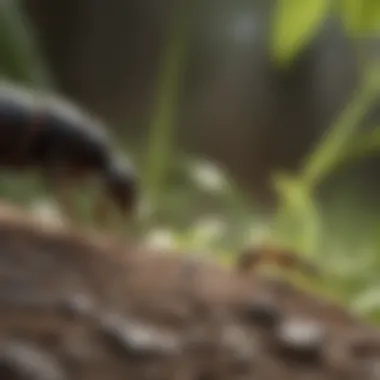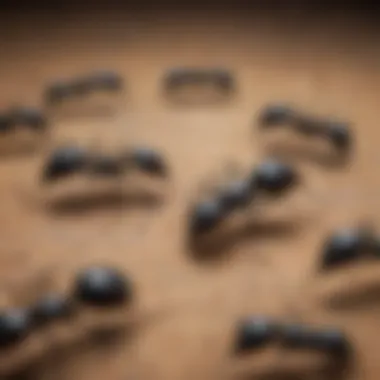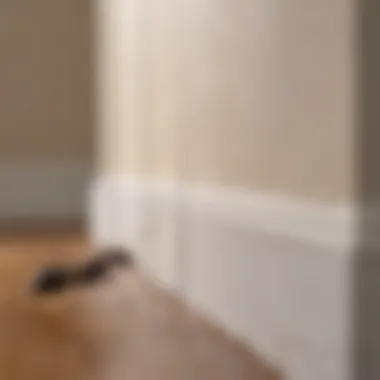Effective Methods to Eliminate Black Ants in Your Home


Intro
Black ants can be a nuisance in homes, causing distress for homeowners. Contrary to popular belief, these pests are not just a minor inconvenience; they can indicate larger issues related to cleanliness or property damage. Understanding the methods to efficiently manage and eliminate black ants is essential for maintaining a comfortable living environment. This guide aims to explore effective techniques for both prevention and extermination, ensuring you are equipped to tackle any black ant invasion.
Animal Species Profile
Prolusion to the Animal Species
Black ants, mainly referring to species in the Formica and Lasius genera, are common across various habitats. They thrive in diverse environments, often establishing colonies in soil or wood. Their presence in homes usually indicates the search for food or shelter.
Physical Characteristics and Appearance
Black ants typically range from 2 to 25 millimeters in length, depending on the species. As their name suggests, they are often identifiable by their predominantly dark coloration. They possess six legs, large mandibles, and a segmented body, making them versatile for various activities.
Natural Habitat and Distribution
These ants can be found in both urban and rural settings across the globe. They prefer environments that offer easy access to food and moisture. Common nesting sites include garden soil, leaf litter, and even inside homes in hidden crevices.
Behavior and Social Interactions
Black ants exhibit complex social structures, living in colonies that can range from a few individuals to thousands. They communicate primarily through pheromones, which help them coordinate activities such as foraging and nest maintenance. The division of labor is a key aspect of their social organization, with designated workers, soldiers, and reproductive individuals.
Prevention Methods
Preventing black ants from invading your home is crucial. Here are some effective strategies:
- Seal Entry Points: Identify and close gaps around windows, doors, and foundations. Use caulk or weather stripping.
- Maintaining Cleanliness: Regularly clean surfaces to remove food particles and spills that may attract ants.
- Proper Food Storage: Store food in airtight containers and avoid leaving pet food out.
Identification of Ant Species
Differentiating between ant species can help tailor your extermination strategy. Look for:
- Size: Black ants are usually medium-sized.
- Color: Predominantly black but some may show reddish or brownish hues.
- Antennae structure: Antennae are elbowed, which is a common feature in many ant species.
Extermination Techniques
When prevention fails, you may need to resort to extermination methods. Options include:
- Chemical Baits: Products like Raid Ant Baits attract and kill ants. Follow instructions carefully for best results.
- Granular Insecticides: Ant killer granules can be spread around nesting areas.
- DIY Solutions: Mixtures of vinegar and water or soap water can disrupt their trails and deter them from entering.
Eco-Friendly Solutions
For environmentally conscious homeowners, consider these alternatives:
- Essential Oils: Peppermint and tea tree oils may repel ants. Mix with water and spray around entry points.
- Diatomaceous Earth: This natural powder is non-toxic and can be sprinkled around infested areas to dehydrate and kill ants.
"Effective ant control requires a combined approach of prevention, identification, and targeted extermination techniques."
Culmination
Managing black ants in your home is a multifaceted process. By understanding their behavior and effective methods for extermination and prevention, homeowners can take charge of their domestic spaces. This not only leads to a more hygienic home but also promotes a peaceful living environment. Implement these strategies and enjoy an ant-free home.
Understanding Black Ants
Understanding black ants is essential for homeowners who wish to manage these pests effectively. Black ants, specifically the species known as the Lasius niger, are common household invaders. Recognizing their behavior and habits helps in identifying their presence before they become an infestation.
Knowledge about black ants not only aids in effective elimination strategies but also informs preventive measures. homeowners can take action earlier, thus minimizing damage and disruption. The more one comprehends these ants, the better equipped they are to maintain a comfortable living space.
Identifying Black Ant Species


Identifying black ant species is crucial when addressing an ant problem. Commonly, one may encounter the Carpenter ant and the Odorous house ant. Both species have unique traits which help highlight their differences.
- The Carpenter ant is larger, ranging from 1/4 to 1/2 inch in length. They often create nests in wood, which makes them problematic as they can damage structural integrity.
- The Odorous house ant is smaller, about 1/8 inch long, and emits a distinctive smell when crushed, similar to rotten coconut.
To accurately identify the species, observe their size, color, and behavior. Collect samples if possible. This identification process can lead to a more tailored approach when developing eradication strategies.
Common Habitats and Behaviors
Black ants are versatile and adaptable, thriving in various environments. Inside homes, these ants are typically found in kitchens, bathrooms, and basements because of easy access to food and moisture. Outside, they prefer to build nests under rocks, in soil, or within wood structures.
Understanding their habitat gives insight into their behaviors. For instance, black ants are social insects and live in colonies. The presence of food sources may provoke them to invade homes. Their foraging behavior is systematic; ants leave pheromone trails to guide coworkers to food. Removing these trails can be an effective strategy against them.
Overall, knowing where black ants live and how they behave is fundamental in formulating an effective plan of action against their presence.
Why Black Ants Invade Your Home
Understanding the reasons black ants invade homes is essential for effective pest management. Black ants, especially species like the carpenter ant and odorous house ant, often enter residential spaces in search of food, water, and shelter. Recognizing these attraction factors helps homeowners prepare and implement preventive measures. Additionally, awareness of ant activity patterns throughout the year can guide efficient responses to prevent infestations before they start.
Attraction Factors
Several specific elements attract black ants into your home. These include:
- Food Sources: Food spills, crumbs, and improperly stored food items make homes appealing to ants. They are particularly attracted to sugary substances and proteins.
- Moisture: Leaky pipes, standing water, or humid environments draw ants seeking hydration. Areas around kitchens and bathrooms are common hotspots due to moisture availability.
- Shelter: Cracks in walls, gaps under doors, or openings around windows can provide easy access points for ants. Once inside, they often establish nests.
One effective approach to limit these attractions is to maintain organized food storage. For instance, keeping mAssive containers and airtight seals enhances protection against these pests. Minimizing moisture by fixing leaks is critical as well. Consider utilizing dehumidifiers in damp areas to create an unfavorable environment for ants.
Seasonal Patterns of Ant Activity
Black ant activity varies by season, impacted heavily by weather and environmental factors.
- Spring: This is the season when black ants become especially active. As temperatures rise, colonies begin foraging for food after winter dormancy. Homeowners might notice increased ant sightings during this time.
- Summer: Colonies can grow rapidly in summer. Mating and reproduction occur, leading to potential nesting inside homes.
- Fall: As temperatures drop, ants will search for warmth and food in homes. They tend to invade in larger numbers, seeking refuge before winter.
- Winter: Ant activity decreases but does not stop completely. They may shelter within wall voids, making it challenging for homeowners to detect infestations until spring.
Understanding these seasonal behaviors helps homeowners anticipate and act accordingly. Avoiding food left exposed during the spring and summer months is critical in preventing ant invasions. Keeping homes clean and monitoring for signs of ant activity year-round ensures better management of potential infestations.
Preventing Ant Infestations
Preventing ant infestations is a crucial aspect of managing your home environment. Black ants are known for their resilience and ability to find food sources. By taking steps to prevent them from entering your living space, you can significantly reduce the chances of an infestation. Prevention not only saves you from the hassle of dealing with these pests but also helps maintain a sanitary home, minimizing the risk of other pest problems. Over time, consistent preventive measures can also become second nature, simplifying your household management.
Sealing Entry Points
One of the first and most critical steps in preventing black ants from invading your home is sealing entry points. Ants can enter through the tiniest of cracks and crevices. Inspecting your home’s foundation, windows, and doors for gaps is essential. Once you identify potential access points, use caulk or weather stripping to seal them off. This not only blocks ants but also improves your home’s energy efficiency.
Maintaining Cleanliness
Maintaining cleanliness is vital to deter black ants. A clean home reduces the likelihood of attracting these pests. When surfaces are free from food particles and spills, ants have less incentive to invade your space.
Correct Food Storage Practices
Proper food storage practices are critical in keeping your home ant-free. Store food items in airtight containers to prevent scent trails that attract ants. This is essential in kitchens and pantries. Many homeowners benefit from these practices as it keeps food fresh and minimizes waste, making it a popular choice. The unique feature of airtight storage is its effectiveness in eliminating food access, which directly correlates to fewer ant encounters. However, neglecting proper storage can lead to serious ant problems, making it crucial for every household.
Regular Waste Disposal
Another important factor is regular waste disposal. Ants are often attracted to food waste, so it is essential to remove trash frequently, especially if it contains food remnants. Keeping bins sealed and disposing of waste promptly minimizes access for pests. This practice is straightforward to implement and offers long-term benefits by ensuring that your living environment remains hygienic and less inviting to ants. The main advantage of regular waste disposal is its simplicity. Nonetheless, overlooking it can result in unwanted infestations, emphasizing the necessity of incorporating this rule into daily routines.
Yard Maintenance Techniques
Yard maintenance techniques play a significant role in preventing ant infestations. Keeping your lawn tidy, trimming shrubs, and removing debris reduces the likelihood of ants finding shelter close to your home. Proper yard maintenance not only preserves the aesthetics of your outdoor space but also establishes a buffer against pest populations. By creating a clean and maintained yard, you can diminish the chances of ants approaching your living area.
Methods for Eliminating Black Ants


Eliminating black ants requires a strategic approach. It is essential to combine various methods to achieve effective results. These methods range from chemical treatments to natural remedies and homemade solutions. Each method has unique characteristics that contribute to an overall pest management plan. The importance of utilizing effective extermination methods cannot be overstated, especially for homeowners seeking peace and comfort in their living spaces.
Chemical Treatments
Chemical treatments often provide quick and effective solutions for black ant control. However, it is crucial to use these methods cautiously.
Overview of Common Pesticides
Common pesticides include products such as Raid Ant and Roach Killer and Ortho Home Defense. These commercial solutions contain active ingredients like pyrethroids and neonicotinoids. Their rapid action kills ants on contact. A significant characteristic of these pesticides is their convenience and availability. Many homeowners prefer them for immediate relief from ant issues. However, one must consider the potential environmental impacts and ensure safe application in households with pets and children.
Application Guidelines
Proper application of chemical treatments is vital for effectiveness. This often involves following instructions on the product label carefully. Key guidelines include applying in areas where ants are most active, such as trails, near entry points, or nests. It is a benefit to reapply after heavy rain or according to the product’s schedule. Unique features of these guidelines ensure that the application achieves maximum results while minimizing risks. However, reliance solely on chemical methods can lead to resistant ant populations over time.
Natural Remedies
An increasing number of homeowners prefer natural remedies due to environmental concerns. These options are often less harmful to the ecosystem.
Vinegar Solutions
Vinegar solutions function as a dual-purpose tool for ant elimination and repelling. A mixture of equal parts vinegar and water sprayed onto ant trails can disrupt the pheromone paths that guide their movement. A key characteristic of vinegar is its non-toxic nature, making it safe for homes with children and pets. The unique feature of this solution is its ready availability, as most households have it on hand. However, it might require frequent reapplication for consistent effects.
Boric Acid Formulations
Boric acid is another effective natural remedy for ants. It functions as a bait that the ants carry back to their colonies, eventually killing the entire colony. The characteristic of boric acid is its slow action, which allows for better control in some cases. Many people prefer it as it is less harmful to humans and pets when used correctly. However, improper use can lead to accidental poisoning if not handled with care.
Essential Oils Application
Essential oils such as peppermint, tea tree, and lemon are becoming popular for ant control. These oils are known for their strong scents that mask ant trails. A key feature of essential oils is their pleasant aroma compared to chemical treatments. They provide a natural alternative for homeowners concerned about the toxicity of synthetic pesticides. However, the effectiveness might vary and may require multiple applications for lasting results.
Homemade Baits and Traps
Homemade baits and traps offer practical solutions for ant management, often with minimal costs.
DIY Ant Baits
DIY ant baits can be made from simple ingredients like sugar and boric acid. These baits attract ants while delivering a lethal dose. A notable benefit is that they can be customized to address specific colony feeding habits. This characteristic can enhance effectiveness in certain scenarios. However, the preparation may take some time, and results might be slower compared to chemical options.
Sticky Traps Preparation
Sticky traps are an excellent way to monitor and reduce ant populations. They involve using adhesive boards placed in areas where ants frequently travel. The key feature here is their simplicity; they require no complex setup or harmful chemicals. The advantage of sticky traps is that they capture ants without killing them instantly, giving an insight into the level of infestation. However, the downside is that they may only control a small number of ants. Results can be slower than expected, requiring patience from the homeowner.
Using a combination of strategies tailored to the situation can yield the best results in eliminating black ants.
Evaluating the Effectiveness of Treatments
When dealing with black ant infestations, understanding how to evaluate the effectiveness of treatments is crucial. This evaluation process helps you determine whether the strategies implemented are yielding positive results. It allows for timely adjustments in approach, ensuring that your home remains free from these persistent pests. Key elements in evaluating effectiveness include monitoring ant activity and assessing treatment outcomes, both of which will be discussed in detail below.
Monitoring Ant Activity
Monitoring ant activity is an essential part of evaluating treatment effectiveness. This involves observing the presence and behavior of ants in your home after applying any extermination method. Keeping a close watch on areas where you previously noticed ant activity can provide insights on whether your chosen method is working.
Consider the following approaches for effective monitoring:
- Track Ant Movement: Pay attention to ant trails. If ant activity decreases significantly, it may indicate successful treatment.
- Periodical Checks: Set a schedule for regular checks to observe any changes. Weekly inspections can help identify if the ant population is decreasing or if they continue to invade.
- Use Sticky Traps: Placing sticky traps in strategic locations can help capture ants. This will allow you to quantify the levels of activity and see if treatments lead to notable declines.
- Check Bait Stations: If you use bait stations, replace the baits periodically and check for signs of ant activity. The presence of dead ants in the stations may show that the baits are effective.
"Regular monitoring of ant populations post-treatment is vital. It guides homeowners in adjusting strategies efficiently to combat black ants."
Assessing Treatment Outcomes


After monitoring, it is important to assess the outcomes of the treatments employed. This involves evaluating whether the methods used have led to a significant reduction in black ant populations. Here are some factors to consider:
- Duration of Ant Activity: Take note of how long ant activity has been observed post-treatment. A decreasing trend over several weeks is a positive sign.
- Comparison with Previous Levels: Compare current ant numbers with your initial observations. A clear decline indicates successful intervention.
- Reinfestation Rate: Assess if and when ants reappear. A low reinfestation rate suggests that the treatment not only worked temporarily but has also deterred future invasions.
- Feedback from Household Members: Gather insights from other residents about their observations. Collective experiences can highlight unnoticed ant behavior.
Evaluating effectiveness is equally as vital as treatment application itself. This proactive approach ensures persistence in keeping your living spaces free from black ants, thereby maintaining hygiene and reducing potential hazards associated with infestations.
When to Call a Professional
Dealing with black ants can be a frustrating experience for many homeowners. This is especially true when the infestation becomes overwhelming. While many will attempt to handle the situation independently using various methods, there are instances where calling a professional pest control service becomes necessary. The benefits of enlisting expert help often outweigh the perceived costs.
First, it is important to recognize the signs of a severe infestation. When black ant populations grow rapidly, it can indicate a well-established colony nearby. Homeowners should look for increased activity, visible trails, and nests. Ignoring these signs can lead to extensive damage and further complications.
Identifying Severe Infestations
Understanding what constitutes a severe infestation is crucial. Here are some signs that indicate it might be time to contact a professional:
- Large Ant Trails: If you see lines of ants consistently traveling across surfaces, this can indicate a strong colony.
- Visible Nests: Finding nests indoors or close to the foundation of your home signals a problem.
- Signs of Damage: Black ants, while not the most damaging pests, can occasionally cause issues particularly if they start to invade wood structures.
- Recurrent Issues: If you have treated the problem several times without long-term success, this suggests an underlying issue that professional methods can address.
By recognizing these signs early, homeowners can prevent a minor ant problem from evolving into a significant issue.
Choosing the Right Pest Control Service
Selecting the appropriate pest control service is an important step in addressing an ant infestation. Not all exterminators are created equal. Here are crucial factors to consider when choosing a service:
- Experience and Credentials: Look for companies that have been in the industry for a while and have the necessary licenses and certifications.
- Reputation: Online reviews and recommendations from neighbors can provide insight into the effectiveness of the service.
- Methods Used: Inquire about the types of treatments the company uses. A service that offers eco-friendly solutions may align with more environmentally cautious homeowners.
- Guarantees: A reliable pest control company should provide guarantees for their services, ensuring their effectiveness.
- Customer Service: Prioritize companies that exhibit good communication and are willing to address your concerns.
"Not all exterminators are created equal; choose wisely based on experience, reputation, and methods used."
Case Studies and Success Stories
In the realm of pest control, case studies and success stories serve as pivotal examples that not only illustrate the effectiveness of various methods for eliminating black ants but also provide a tangible sense of hope for homeowners facing infestations. These narratives allow individuals to grasp the real-world impact of strategies they may be considering, creating a bridge between theoretical knowledge and practical application.
By examining specific homeowner experiences, we gain insights into the challenges encountered and the solutions implemented. This real-life perspective is critical in understanding which methods are truly effective in different scenarios. Additionally, success stories encourage those struggling with similar problems to adopt actionable strategies. They also highlight the importance of persistence and adaptability when addressing pest issues.
Homeowner Experiences
- Case Study: Organic Approach in Suburban Home
A homeowner in a suburban area reported a significant black ant invasion in his kitchen. Concerned about chemicals, he sought organic solutions. After researching various natural remedies, he decided to use a combination of vinegar and essential oils as deterrents. - Case Study: Professional Help with Severe Infestation
A family living in a historic home faced a severe infestation. Their attempts using store-bought insecticides failed to eradicate the problem.
- Implementation: The homeowner wiped surfaces with a vinegar solution daily and applied essential oils around entry points.
- Outcome: Within two weeks, ant activity decreased notably. The homeowner was satisfied with the results and relieved to avoid harsh pesticides.
- Decision to Call Experts: They decided to hire a pest control service specializing in ant species.
- Assessing Success: Post-treatment, the family noticed a drastic reduction in ant sightings and felt more comfortable in their space.
Comparative Analysis of Methods
Analyzing different methods is essential to determine which approaches yield superior results against black ants. Various strategies—ranging from chemical treatments to natural remedies—have their advocates and critics.
- Chemical Treatments:
Chemical solutions like Raid Ant Gel or Ortho Home Defense are popular choices. They offer immediate results but often come with health and environmental concerns. Homeowners should factor the severity of the problem and the presence of children or pets when choosing this route. - Natural Remedies:
DIY solutions, as seen in homeowner experiences, often include substances like boric acid or diatomaceous earth, recognized for their effectiveness without harmful chemicals. These can take longer to show results but may be preferred for those conscious of health implications. - Professional Services:
On the other hand, professional pest control services combine chemical and eco-friendly methods tailored to the specific situation. They can provide comprehensive solutions but may incur higher costs.
Those looking to eliminate black ants in their homes must weigh these methods based on personal circumstances, preferences, and the level of infestation. The discussions we're having here can offer clarity and direction, ultimately leading to ant-free homes.
Ending
In this article, we explored the multi-faceted approaches to effectively eliminate black ants from your home. Understanding the behavior, habitats, and methods of prevention are key to managing an ant problem. This knowledge empowers homeowners to take control of their environment, minimizing pest attractions and safely addressing infestations when they occur.
Recap of Key Strategies
To ensure a thorough approach to ant elimination, the following strategies are crucial:
- Preventive Measures: Sealing entry points and maintaining cleanliness helps deter black ants from entering your home.
- Identification: Knowing the specific black ant species present aids in choosing the most effective elimination method.
- Treatment Options: Options range from chemical pesticides to natural remedies like vinegar and boric acid, catering to different preferences and concerns.
- Monitoring: Regularly checking for ant activity ensures that you can address any resurgence in a timely manner.
- Professional Help: When infestations become overwhelming, seeking expert intervention is advisable, as they can provide tailored solutions based on the severity of the problem.
Future Considerations for Homeowners
As you look to maintain a pest-free home, consider the following:
- Sustainability: Choosing eco-friendly pest control methods is becoming increasingly important. Evaluate options that are safe for both humans and pets, reducing chemical exposure in your home.
- Education: Stay informed about new methods and strategies in ant management. Engage in discussions on platforms like reddit.com or facebook.com for shared knowledge and community support.
- Continuous Improvement: Regular home maintenance can prevent future infestations. Make inline checks part of your routine and always update your prevention strategies based on seasonal patterns.
- Research: Understanding the ecosystem around your property can shed light on natural pest control methods, working towards a balanced habitat.







